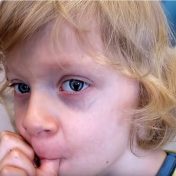
The Best DNA and Ancestry Products Compared
How Many Chromosomes Do Humans Have?
Chromosomes and Your DNA
Advertising Disclosure
Many or all of the companies featured provide compensation to us. These commissions are how we maintain our free service for consumers. Compensation, along with hours of in-depth research, determines where & how companies appear on our site.
The chances are good that you stumbled onto this page after looking at our Ancestry DNA test or one of our other reviews. We spent hours reading online articles and examining those tests for ourselves to find out which ones were the best for our readers. These tests look at your DNA samples and can determine where your family line started and how members of your family moved throughout history. The odds are also good that you don’t understand how those tests work and what chromosomes are or where they are in your body.

Scientists chose the name chromosome because it’s a derivative of a Greek word that means both body and color. Those two terms let you know that a chromosome has some type of color and that it has a small body. You cannot view a chromosome, even if you look at a blood sample under a microscope. Though it is quite small, it contains the genetic and DNA material that makes up who you are. Though you may want to know more about chromosomes, you’ll also want to find out how many they are in the human body. We’ll go over numbers and other information in this guide to human chromosomes.
What Do Chromosomes Do?
Have you ever had someone tell you that you look just like your mother or father? The resemblance between two or more family members is there because of the chromosomes that they pass down the family line. Some people call chromosomes building blocks because they actually help determine what you will look like and which traits you will get from your parents and other ancestors. You typically get half of your genetic makeup from your mother and half from your father. The way those chromosomes work together can determine whether you look more like one relative than the other or whether you look like both of your parents.
Every living organism uses a process called cell division as it grows and develops. This occurs as the cells divide and grow over time. Cell division is important because this makes sure that the organism has the proper number of cells and that the organism grows and develops in a healthy way.
Chromosomes are so important because these building blocks are what the cell uses to retain its shape and size. As the cell develops, the chromosomes will keep the cell from growing too large and will work with the cell to ensure its healthy development.
How Many Chromosomes Do Humans Have?
A good way to decide which of the top DNA tests is right for you is with a look at a comparison between two of those kits. You can use our AncestryDNA to 23andMe comparison to see how those two kits compare. One thing you may want to know before you take that test is how many chromosomes you actually have. The average human has a total of 46 chromosomes. This includes 23 distinct pairs, which is where the 23andMe testing kit gets its name. Half of the genetic material is each pair comes from your father, while the other half comes from your mother. Your parents will also have 46 chromosomes with half of their genetic material coming from their mothers and the other half from their fathers.
According to the March of Dimes, the number of children born with a chromosomal condition is around one out of every 150 kids born today. A chromosomal condition typically occurs because of the genes that the parents pass down. One example is a condition that occurs when there are more or less chromosomes in a sequence. Children can also suffer from conditions caused by changes to the structure of those chromosomes.

Chromosomal Conditions
One reason you may want to trace your genealogy and family line is because you want to see if any of the more common chromosomal conditions run in your family. If you have one family member with Down’s Syndrome or another condition, you have a greater chance of having children with that same condition. Though the MyHeritage test kit and similar kits may not give you much health information, 23andMe does offer health testing and wellness screening. This test can let you know what traits and carriers you have that come from your parents.
Down’s Syndrome is just one of the genetic conditions that your own child might have. More than 50% of the women who miscarry today do so because of chromosomal conditions that keep the baby from developing in the womb. You can request an ultrasound early in your pregnancy to look for these conditions. Doctors can also take a blood test later in your pregnancy. Those tests are important because they let you know what your chances are of having a child with a chromosomal condition. You can use the results to prepare yourself and your loved ones too.
Examples of Chromosomal Conditions





Chromosomes and Genetic Mutations
Now that you know what chromosomes are and what they do, you might wonder why you don’t look exactly like your parents. Even if you look very similar to one parent, you’ll notice some key differences. Your father’s nose might be a little longer or he might have a heavier body type. The reason you don’t look exactly like one or both of your parents is that of genetic mutations. The genes that come from your parents are hereditary genes. As your own cells grow and divide during your own development, small mutations will occur that makes you fundamentally different from your ancestors. Even if you have a twin, you might have some noticeable differences.
These mutations will not give you superpowers like the X-Men and other comic book characters have, but they will make you the person that you are. You might have a mutation that causes you to have a completely different hair color than either of your parents. This commonly occurs with those who have red hair. Red hair is a recessive trait that can pass from one family member to another all the way down the line. You might be the first in your family in several generations to have red hair.

Genetic Traits
Many high schools once did basic tests in biology classes that allowed students to compare their blood types to the types of their parents. Schools stopped doing these tests after discovering that some students learned they were adopted or were not the biological children of their parents. Blood type is just one example of a genetic trait, which is a trait that you get from your parents. If both your parents have Type B blood, it’s impossible for you to have Type A blood. You should know your blood type in case of an accident or an injury that requires a transfusion later.
The traits that you demonstrate can come from your environment or from your genes. Eye color and height are two examples of genetic traits. If both of your parents are tall, the chances are high that you and your siblings will also be tall. Genetic mutations can result in dwarfism and other conditions though. Whether or not you can curl your tongue is also a genetic trait. Huntington’s disease is a serious medical condition that also passes down through a family line. You can carry genes that make you more susceptible to developing Alzheimer’s disease and other conditions.
Symptoms of Huntington's Disease





What Genetic Testing Can Tell You
Anyone interested in their family history and genealogy should consider having genetic testing done. You can use an at-home test such as the 23andMe kit to get some information about your general and overall health and wellness. Most tests require just a small saliva sample, though some require a sample taken from the inside of your mouth. If you speak to a genetic counselor, you may need to submit a blood sample too.

These tests can give you different results about your health, including:
- Drug response: This test shows you how you will respond to different types of prescription and over the counter drugs. You may learn that you have a greater chance of suffering an allergic reaction to some medications or that other drugs will not work with your biology.
- Genetic carrier: Though AncestryDNA and other tests do not offer carrier testing, 23andMe and other kits do. This tells you whether you carry the genes that predispose you to certain medical conditions and whether you can pass those genes down to your kids.
- Genetic traits: A fun aspect of these tests is that you can view the genetic traits you have. You'll find out whether you might suffer from hair loss, if you are more sensitive to caffeine than others and even if you have troubles sleeping because of your genes.
Your Genes and You
Every human being in the world has a different genetic makeup, but they share many of those genes with their ancestors. You can take the MyHeritage test or any of the other popular tests to see how your genes connect you to people who live and still live in countries all around the world. Most of these tests give you the option of connecting with those family members online and sharing your information with the public.
If you aren’t sure which test is worth your money, our 23andMe comparison to AncestryDNA can help. These tests will determine your genetic makeup based on the sample that you submit and the comparison that the test does to the samples provided by other users in the past. We hope that you learned the basics of human chromosomes, DNA and genes in our guide and that you understand how these tests work before you buy.

